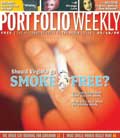When a class action lawsuit was brought against the tobacco companies on behalf of thousands of non-smoking flight attendants in the early Ď90s for health damages created by exposure to secondhand smoke, I thought that a similar legal proceeding should be taken on behalf of musicians. Few people have been forced to inhale doses of those noxious fumes as large or as intense as musicians playing in clubs, bars and restaurants. Even now, when smoking is no longer cool and the health risks are universally known, musicians are often stuck in the smoking side of the places they play.
I canít begin to count the number of late nights and early mornings when I have arrived at home after a gig drenched in the foul aroma of cigarette smoke. I canít stand to sleep with myself at such times, much less expect my wife to sleep next to me. Manyís the time Iíve gotten home at three oíclock in the morning after a long drive from Williamsburg, worn out after a full day of working a real job followed by four sets in a smoke-filled room, only to have to take a lengthy shower to expunge the odor from my hair and body. My clothes go right into the washing machine, my instruments outside to air out.
One of the most memorable stories from my days playing music on the road is of a night in Charlotte (or maybe it was Raleigh) thirty years ago. It was in a big barn of a dance club that held a couple of thousand people, and apparently the ventilation system was on the blink. As the evening rolled on and we cranked out an endless stream of early disco hits, the atmosphere became thicker and thicker with smoke. There came a point when we could hardly see the gyrating dancers for the fog.
Onstage, the guys in the band could not find potable air to breathe. But there was a tiny shaft of light and air between the smoke layer and the stage floor, maybe a foot in height. We had to literally squat down with our faces in our shoelaces, take a deep breath, and then rise up to play a few notes into the microphones.
Breathing in secondhand smoke isnít just a nasty nuisance to a musician, nor is it a mere toxic health threat as it is to everyone else. It is an impediment that hampers your ability to perform. For a singer, it changes the timbre of your voice, making you sound like you have an incurable cold, robbing you of what vocal richness you may actually possess. Horn players need a chest full of oxygen in order to coax those melodious sounds out of their trumpets, trombones, saxophones and flutes.
Of course, for musicians, as for waiters and waitresses, the smelly hair and clothes and temporarily impaired musical skills are the least of the concerns when it comes to secondhand smoke. As a poster I saw online recently of a young woman carrying a beer on a serving tray said, ďThe smoke will wash out of her clothes. But what about her lungs?Ē
According to the Journal of the American Medical Association, five minutes of exposure to secondhand smoke stiffens your aorta as much as smoking a cigarette; twenty minutes and the platelets in your blood are like those of a pack-a-day smoker; a half hour of secondhand smoke produces the same damage to your coronary arteries as that found in a regular smoker.
Statistics like those are worrisome and serve to underscore the crummy feeling you get after a night of burning eyes, scratchy throat and phlegm-filled sinuses. How much damage has already been done?
Nowadays, plying my trade as a jazz musician, I am not usually working in a smoke-filled bar. But thatís primarily because there arenít any jazz clubs around here, so weíre usually playing in places like the Chrysler Museum and other arts-type facilities or in festival settings. Local rock and blues musicians and acoustic performers still find themselves buried in clouds of smoke. And the two best known (now defunct) local jazz venues of recent years, Bienville Grill and Blues Alley, both fine restaurants that allowed smoking only at the bar, provided ample proof that simply segregating smokers does not prevent the second-hand smoke from wafting its way throughout the room. When the next jazz spot does open up, Iíll likely be stuck with the decision of playing in an unhealthy environment or not playing at all.
Iíve talked with restaurateurs through the years about their smoking policies, and Iím pleased to report that more and more are making the choice to go smoke-free. Others admit theyíd like to do so, but are afraid of losing business. Even though studies show that in states and localities that have implemented smoke-free laws business actually improves, itís hard to be the only one on your block doing the healthful thing, I suppose. An encouraging nudge from the lawbook is helpful and provides cover for those whoíd like to do the right thing anyway.
So itís a shame that Virginia hasnít gotten on the smoke-free bandwagon yet. Surely thatís bound to changeÖisnít it?

